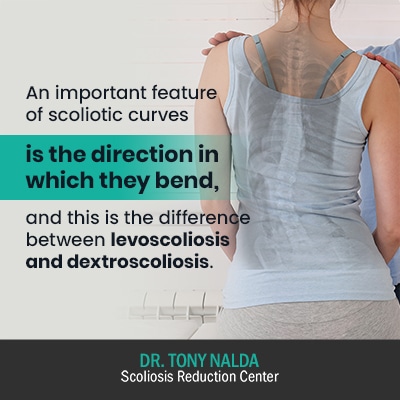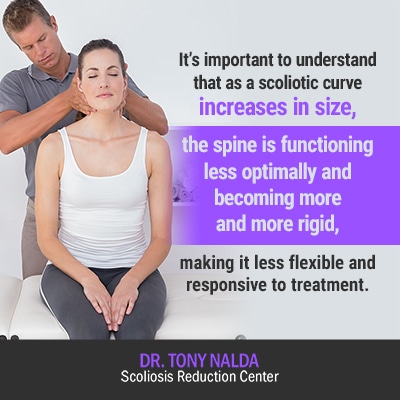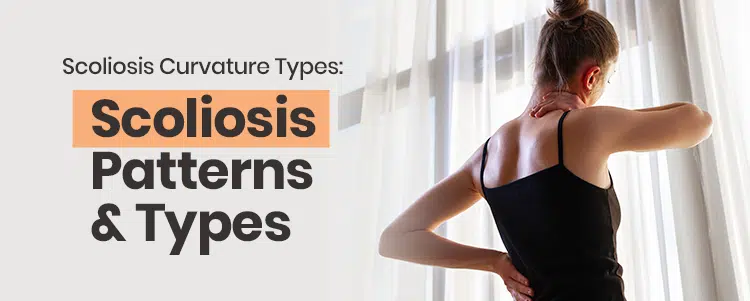Part of the reason scoliosis is so often described as a complex and/or mysterious condition is because we don’t fully understand its causation, and there are multiple condition forms and curvature types. Scoliosis curvature type is important because it tells me whether or not a scoliosis is considered typical or atypical.
Scoliosis is classified based on a number of important patient/condition characteristics, curvature type being one of them. While most commonly, a scoliotic curve bends to the right, there are curvature types that bend to the left, and scoliosis can develop in any section of the spine.
Before we delve into the specifics of scoliosis curvature types and patterns, let’s first touch on how the condition is further classified as part of the diagnostic/assessment process.
Classifying Scoliosis
When a person receives a scoliosis diagnosis, it means they have an abnormal sideways spinal curvature, with rotation and a minimum Cobb angle measurement of 10 degrees.
The spine is naturally curved at each of its main sections. These healthy spinal curves make the spine stronger, more flexible, and better able to absorb/distribute mechanical stress incurred during movement.
If the spine loses one or more of its natural curves, it is no longer aligned, and this structural change impacts the spine’s overall health, function, and biomechanics.
Part of the diagnostic and assessment process is further classifying conditions based on a number of important patient/condition variables: patient age, causation, severity, and curvature location/type.
Conditions are classified because it helps streamline the treatment process and guide effective treatment plans’ design moving forward.
Patient Age
Regarding scoliosis, patient age is an important factor because it indicates overall health and fitness, whether or not a condition is compressive, and potential progressive rates.
For young patients who have not yet reached skeletal maturity, the condition is not compressive because the lengthening motion of a growing spine counteracts the compressive force of an abnormal spinal curve; this is why scoliosis in children and adolescents is rarely painful, while pain is a common symptom of scoliosis in adults.
In addition, scoliosis is progressive, meaning it’s in its very nature to worsen over time, especially in severe forms and/or if not treated proactively.
While we don’t know what causes every type of scoliosis, we do know how to treat it proactively as a means of staying ahead of the condition’s progressive line.
Scoliosis ranges from mild to moderate, severe, and very severe, and as scoliosis is not a static condition, where it is at the time of diagnosis is not indicative of where it will stay, which is why managing progression is a crucial aspect of treatment.
We know that growth is the number-one trigger for progression, so classifying a condition as congenital, juvenile, adolescent, or adult is a factor that helps indicate whether or not a patient is vulnerable to rapid-phase progression.
Causation
Causation refers to a condition’s etiology, meaning the why behind its development, but we can’t always pinpoint a causative source when it comes to scoliosis, as is the case with the condition’s most prevalent type: idiopathic scoliosis.
Approximately 80 percent of known diagnosed scoliosis cases are classified as idiopathic, meaning that we simply have yet to identify a clear causative source.
The remaining 20 percent of known diagnosed scoliosis cases fall into one of the following categories: congenital, neuromuscular, degenerative, or traumatic.
When known, causation is an important variable because it helps inform the crafting of treatment plans that address a condition’s underlying cause, not just its symptoms.
For example, in cases of neuromuscular scoliosis, the abnormal spinal curve develops due to the presence of a larger neuromuscular condition/disease, and it’s the underlying disease causing the scoliosis development that needs to guide the treatment approach moving forward.
Condition Severity
Condition severity is determined by what’s known as Cobb angle: a measurement taken in degrees of the most-tilted vertebrae at the apex of a scoliotic curve.
A patient’s Cobb angle tells me how far out of alignment their spine is and places conditions on a severity scale of mild, moderate, severe, or very severe.
- Mild scoliosis: Cobb angle measurement of between 10 and 25 degrees
- Moderate scoliosis: Cobb angle measurement of between 25 and 40 degrees
- Severe scoliosis: Cobb angle measurement of 40+ degrees
- Very-severe scoliosis: Cobb angle measurement of 80+ degrees
Condition severity is an important classification factor because it helps predict progressive rates/symptoms a patient is likely to experience. However, it’s also important to understand that no two cases are the same as a highly variable condition.
Curvature Location/Pattern
Curvature location/pattern is important not only because it tells me which area of the spine to focus treatment on but also because certain scoliosis curvature types and patterns indicate progressive rates and causation.
As mentioned earlier, most scoliotic curves bend to the right, away from the heart, but in atypical condition types, the curve can bend to the left in a ‘C’ shape, towards the heart, known as levoscoliosis.
When I see a scoliotic curve that bends to the left, this is a red flag that there is an underlying pathology at play that’s caused the scoliosis to develop as a secondary complication, including neuromuscular conditions and spinal injury, and/or the presence of spinal tumors.
The spine has three main sections: cervical (neck), thoracic (middle/upper back), and lumbar (lower back).
While thoracic scoliosis is the most common location, it can develop anywhere along the spine.
So if a diagnosis of lumbar scoliosis is given, this means the lower back has developed an unnatural sideways spinal curve, while thoracic scoliosis means the middle/upper back is affected, and cervical scoliosis indicates the presence of a scoliotic curve in the neck.
Scoliotic curve patterns are also not limited to one spinal section at a time; for example, cases of thoracolumbar scoliosis reference patients whose scoliotic curve develops in the lower thoracic and upper lumbar spinal sections.
As such a highly-prevalent spinal condition, scoliosis curvature types and patterns have been well documented with single thoracic curves being the most common curvature pattern accounting for 37 percent of known diagnosed cases; single lumbar curves account for 30 percent, double major 13 percent, single thoracolumbar also account for 13 percent, and double thoracic accounting for 6.6 percent.
The most prevalent scoliosis curvature types are right thoracic (28 percent) and left lumbar curves (22 percent).
Now that we have addressed the prevalence of scoliosis curvature types/patterns let’s further explore the defining features of different types of spinal curvatures.
Types of Scoliosis Spinal Curvatures
It’s important to understand that scoliosis is a 3-dimensional condition; it doesn’t just bend to the side, but with the rotational component, it also twists from front to back, back to front.
Considering how complex a structure the human spine is and how highly variable a spinal condition scoliosis is, it makes sense that an abnormal spinal curvature can be equally complex and have multiple classification points.

An important feature of scoliotic curves is the direction in which they bend, and this is the difference between levoscoliosis and dextroscoliosis.
Levoscoliosis
As mentioned, most scoliotic curves bend to the right (dextro), away from the heart, but some curvatures bend to the left (levo), towards the heart, and when this happens, it’s a sign that there is an underlying pathology at play and is known as levoscoliosis.
When levoscoliosis is diagnosed, this is considered an atypical form; levoscoliosis curves bend to the left in a ‘C’ shape.
While levoscoliosis can affect the thoracic spine, it most commonly develops in the lumbar spine (lower back), so a diagnosis of lumbar levoscoliosis means a scoliotic curve that bends to the left is present in the lower back.
While each case is different and a person’s experience of life with levoscoliosis will be shaped by other important patient condition/factors, common symptoms of levoscoliosis can include:
- Uneven shoulders
- Uneven hips
- A head that is not centered over the torso
- Arms/legs that hang at different lengths
- The presence of a rib arch
- An abnormal spinal curve that’s visible to the naked eye
- Ill-fitting clothing
As is the case with most forms of scoliosis, the main visual symptom is how the condition disrupts the body’s natural symmetry; this is because a spine with an abnormal spinal curve is not optimally aligned.
Again, while every case is different if levoscoliosis goes untreated or isn’t treated proactively, as a condition progresses in severity, it tends to increase related symptoms and risk of complications such as:
- Back pain (more common in adult levoscoliosis)
- Radicular pain felt in the legs and feet
- Chest pain (most common in thoracic levoscoliosis)
- Headaches and migraines due to cerebrospinal fluid (CSF) irregularities
- Sleep problems
- Digestive issues
Even within levoscoliosis, a condition can be further classified based on whether or not it’s the curve’s inner or outer edge that bends to the left.
Also known as thoracic levoscoliosis, a diagnosis of levoconvex scoliosis is given if it’s the curve’s outer edge (convex side) that bends to the left rather than the curve’s inner edge (concave side) in the spine’s thoracic section (middle/upper back).
While most cases of levoconvex scoliosis affect the thoracic spine, it can also affect the lumbar spine.
Now that we have defined and discussed levoscoliosis and how it’s further classified, let’s move on to the opposite scoliosis curvature type: dextroscoliosis.
Dextroscoliosis
While cases of levoscoliosis are considered atypical, dextroscoliosis is considered typical as it’s the most common scoliosis curvature type: one that bends to the right, away from the heart.
Depending on how severe a patient’s dextroscoliosis is, it can give the spine an exaggerated ‘S’ shape, rather than the soft ‘S’ shape characteristics of a healthy spine or a ‘C’ shape.
Dextroscoliosis most commonly affects the thoracic spine and is most prevalent amongst adolescents between the ages of 10 and 18: adolescent idiopathic scoliosis (AIS).
It’s thought that dextroscoliosis is commonly triggered by the first big pubescent growth spurt.
While every case is different and can range from mild to moderate, severe and very severe, common symptoms of dextroscoliosis can include:
- Uneven shoulders/shoulder blades
- The presence of a rib arch
- Uneven hips
- Uneven waistline
- Changes to gait and balance
- Ill-fitting clothing
As is the case with levoscoliosis, the most common signs of dextroscoliosis will involve postural changes that affect the body’s overall symmetry.
In general, the more severe a condition is, the more noticeable these symptoms can be, and the more asymmetric the body can become. In milder forms, the condition isn’t commonly associated with noticeable functional deficits, and even postural changes can be subtle, which is why early detection can be a challenge.
While there are no treatment guarantees, early detection can increase the chances of treatment success if proactive treatment is applied.
It’s simpler to treat scoliosis while it’s mild before progression has occurred, while the spine is still flexible, and before the body has had time to adjust to the abnormal spinal curve’s presence.
Just like levoscoliosis, dextroscoliosis can be further classified based on location and whether or not it’s the curve’s inner or outer edge that bends to the right.
Also known as lumbar dextroscoliosis, dextroconvex scoliosis commonly causes an ‘S-shaped’ curvature in the lumbar spine with the curve’s outer edge (convex side) bending to the left.
If a diagnosis of thoracic dextroscoliosis is given, this means there is an abnormal spinal curvature that bends to the right in the thoracic spine: the most common spinal section to develop scoliosis.
While each case is different, one of the most common symptoms of thoracic dextroscoliosis is the development of a rib arch as the unnatural spinal curve pulls on the rib cage and distorts its position.
So now that we have defined and discussed the different scoliosis curvature types and patterns let’s talk about what to do once a diagnosis is given: seek out proactive treatment.
Scoliosis Treatment
As mentioned, scoliosis is progressive. While mild forms aren’t known to cause noticeable functional deficits and/or postural changes, where a condition is at the time of diagnosis is not indicative of where it will stay.
If a scoliotic curve is left to progress unimpeded, either due to lack of treatment, or the application of a traditional treatment that values solely observing mild conditions, it will, at some point, increase in size and severity. As this happens, related symptoms and the risk of complications also tend to increase.

It’s important to understand that as a scoliotic curve increases in size, the spine is functioning less optimally and becoming more and more rigid, making it less flexible and responsive to treatment.
In addition, as a scoliotic curve progresses, it introduces more uneven forces to the body, including not just the spine but also its surrounding muscles, ligaments, and nerves.
It’s also important to understand that scoliosis changes once it becomes a compressive condition, and this is the big difference in how children and adolescents experience scoliosis versus adults.
While scoliosis is most commonly diagnosed as adolescent idiopathic scoliosis (AIS), it also affects adults.
For children and adolescents who have not yet reached skeletal maturity, their bodies are still growing, and the lengthening motion of a growing spine counteracts the compressive force of the curvature: the main source of condition-related pain.
In adults who have stopped growing, scoliosis is compressive, and it’s the compression exposed to the spine and its surroundings that’s known to cause varying levels of back, and radicular pain felt throughout the body.
So even if an adolescent goes through puberty with scoliosis unaware, it progresses into adulthood, when it tends to cause noticeable symptoms like pain, as it becomes a compressive condition, and this is the most common type of adult scoliosis: idiopathic scoliosis in adults.
Scoliosis Reduction Center® Treatment
There are two main scoliosis treatment approaches: traditional and conservative. Also known as functional or chiropractic-centered. The conservative treatment is what I offer patients of the Scoliosis Reduction Center®.
Patients of the Center benefit from the application of multiple treatment disciplines as I integrate different modalities for the most specific and effective results.
While there are never treatment guarantees, I believe in the merits of proactive treatment applied as close to the time of diagnosis as possible. I believe in not wasting valuable treatment time to observe conditions for progression when we know it’s in their nature to progress at some point.
I believe in working towards preventing increasing condition severity as this can spare patients the hardships associated with increasing symptoms, potential complications, and the need for more invasive forms of treatment.
So what does Scoliosis Reduction Center® treatment involve? Each case is different, and treatment will involve crafting a comprehensive and fully-customized treatment plan moving forward.
Here at the Center, I integrate multiple forms of treatment that complement one another, and first and foremost, as scoliosis is a structural condition, I want to impact it on a structural level.
I work closely with patients to increase their core strength, so the spine is optimally supported and stabilized through a combination of in-office therapy, custom-prescribed home exercises, corrective bracing, and condition-specific chiropractic care.
Through precise chiropractic adjustments/remodeling, I can work towards adjusting the position of the most-tilted vertebrae so they are better aligned with the rest of the spine, thus restoring as much of the spine’s natural curvatures as possible on a structural level.
The most important thing to understand about scoliosis is that as a progressive condition, the time to act is always now, and proactive treatment is always the best chance of preventing increasing condition severity and the need for more invasive forms of treatment down the road.
Conclusion
Scoliosis is a highly-prevalent spinal condition with close to seven million people currently living with it in the United States alone; as such, the many different scoliosis curvature types and patterns are well documented.
While scoliosis can develop anywhere along the spine, the thoracic spine (middle/upper back) is the most commonly affected.
As an abnormal sideways spinal curve, scoliotic curves can bend to the left (levoscoliosis) or the right (dextroscoliosis), and curvatures can also bend on the outer edge (convex side) or inner edge (concave side) of the spine.
Regardless of the scoliosis curvature type, once a diagnosis is given, the most important decision to make is how to treat it moving forward.
Although there are never treatment guarantees, and scoliosis can range in severity from mild to moderate and severe to very severe, there are two main treatment approaches to choose between, traditional and conservative, each offering patients different potential outcomes.
As mentioned, the traditional approach values observation until a condition reaches a certain severity level, and patients are commonly funneled towards spinal fusion surgery; the conservative approach values proactive treatment initiated as close to the time of diagnosis as possible in the best interest of managing the progression and preventing increasing condition severity.
Here at the Scoliosis Reduction Center®, my approach is also known as functional because, along with impacting scoliosis on a structural level by addressing its true 3-dimensional nature, I believe in preserving the spine’s overall health and function throughout treatment and beyond.
By integrating different treatment disciplines such as in-office therapy, custom-prescribed home exercises, corrective bracing, and condition-specific chiropractic care, I can craft fully customized treatment plans with the potential to impact conditions on multiple levels.
So if you, or someone you care about, has noticed one of the condition’s telltale signs, don’t hesitate to reach out to us here at the Scoliosis Reduction Center® for additional guidance and support.





